
|   |

|   |
 e-mail: sunilkothari1933@gmail.com Trayambakam: Another feather in the cap of choreographer Vanashree Rao Photos courtesy: Rasa United December 7, 2019 There is no doubt that with Trayambakam, the latest choreographic work of Rasa United, Vanashree Rao has emerged as a brilliant choreographer. From a soloist and performing Kuchipudi with her husband Guru Jaya Rama Rao, her forays into choreographing works in three styles - Bharatanatyam, Kuchipudi and Mayurbhanj Chhau - with a brilliant group of male and female dancers, Vanashree sets the stage on fire! There is not a single dull moment throughout the presentation. It grips the audience from the word go. The electrifying dances by the male dancers to the pulsating music, mood lighting and excellent costumes, the visuals hold one's attention.  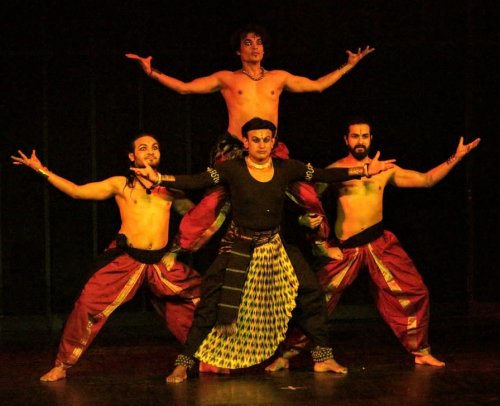 Presented on November 26, 2019 at India Habitat Centre, New Delhi, Trayambakam deals with three approaches trying to understand how a devotee reaches the divine dwelling in the universe as both kinetic and static energies that are as Shakti and Shiva. Human energy forms the third dimension. Vanashree has interpreted static kinetic energies in Ardhanarishwara dance dealing with static 'nirguna', then only kinetic 'saguna' and with story of Kiratarjuniyam, human energy as an extension of the divine embodying both nirguna and saguna. The program is thus divided into Trayambakam, Dwadasha Lingam and Devi. In the first number there are three stories: Aghori, Ardhanarishwara and Kiratarjuniyam. They are set into Bhairava, Amritvarshini and Poorvi Kalyani ragas. When the first sequence starts we are transported to the cremation grounds where as Aghor, Shiva is seen dancing reciting bam bam bam, besmeared with ashes on forehead, trishul design on his back, and his ganas, accompanists also dance, one of them performing head stand, Shirashasana. It is sheer masculine, vigorous Tandava dance and with sound of the conch, Shiva's praise in Tulasidasa's composition 'Bhashma anga, ananga dahana, shira Ganga, bhushana bhujanga' and with crescendo Parama Shiva, the dancers take pirouettes, mesmerizing the onlookers with dynamic energy. Dr Sridhar Vasudevan as Lord Shiva and other manifestations of Aghora by Kuleshwar Kumar Thakur, Arjun Dev Malik and Ram Gautam literally create the cremation grounds in its gory details dancing like zombies! Then follows the Ardhanarishwara aspect. The pair of Shiva and Parvati enacted by that handsome dancer Prashant Kalita and Kuchipudi dancer Moutushi Majumdar reveals the unity of two in one body divided in half each. Prashant with his exquisite Mayurbhanj Chhau movements matches the seductive grace of Moutushi's Kuchipudi. Here lies the imaginative choreography by Vanashree. The two dancers dance the aspect of Siva as Kameshwara and Parvati as Kameshwari with such abandon and joy, one relishes watching them with rapt attention. Their poses in form of Ardhanarishwara are perfectly balanced with Chhau and Kuchipudi movements. The drama unfolds when Parvati (Sati), daughter of Daksha, is humiliated and jumps into fire, Shiva as Virabhadra, loosens his jata -matted locks - screams and lifts the body of Sati and dances with dazzling energy. Prashant Kalita transforms in a trice into wild form of Shiva. 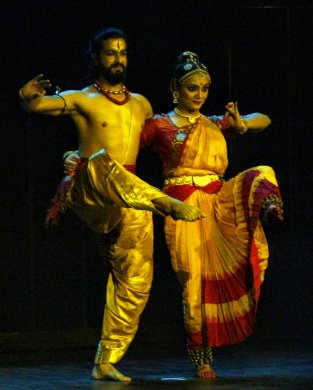 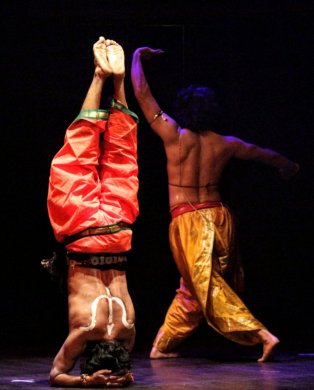
In the episode of Shiva as a Kirata, forest dweller, hunting the boar, Arjuna also shoots the arrow attacking the boar at the same time. Parvati watches the duel between Shiva in disguise and Arjuna as a mendicant doing tapasya for getting Pashupatastra, both competing, and as poet Bharavi says Shiva jumps upwards to heaven, at the same time Arjuna taking that leap. Admiring his devotee, Shiva embraces him and reveals his original form as Shiva and gives him Pashupatastra. Performed by Vasudevan in Bharatanatyam, Arjun Dev Malik as Arjuna in Mayurbhanj Chhau, and Ayana Mukherjee as Parvati in Kuchipudi, watching that young dancer Rohit Kumar Khanojia as a boar moving with great agility, the episode of Kirata and Arjuna won instant applause by the audience. In Dwadasha Jyotirlinga, Vanashree positions five dancers as Panchamukha Shiva circulating on one spot, revealing different forms, in a very imaginative touch. The shlokas describe the locations of the Dwadasha Jyotirlingams in Ragamalika. They are identified as Mahakaleshwara in Ujjain and other sacred places. Vanashree has choreographed episode of Markandeya doing penance, worshipping Lord Shiva's lingam. It is time when Yama arrives to take him away, but Markandeya clings to the lingam. Shiva appears and pushes away Yama, releasing his Yama pasha from neck of Markandeya. Yama bows to Lord Shiva. These touches make Dwadasha Jyotirlingam section interesting. The recitation of Trayambakam Namamahe, Nilakanthaya, Sarweshwaraya, fills the air and the sound of conch, bells take audience to the holy centres. But mere male energy is never enough. It is incomplete without female energy, which is Devi. In final segment, Devi is evoked with chanting of 'Ya Devi sarva bhuteshu Shakti rupena samsthita'. The goddess appears in her resplendent form. Vanashree as Devi camouflages herself with multiple forms of Devi impersonated by Moutushi, Ayana and Shefali Bharati. The goddess is armed with several weapons by the gods, offering her arrows, trident, pasha, and she rides a lion. Vanashree has used poems describing the beauty of the goddess. Karikumbhastana, the enlarged bosom, Sharadachandravadana, face like moon of Sharad ritu, Varnakanchi, the golden hues, and so on. The female dancers stand in front row one behind the other, and shoot arms holding different weapons, creating visual of a multi-armed goddess, holding trident and astride the lion. 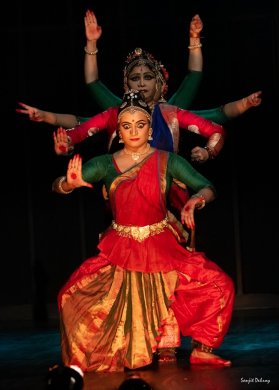 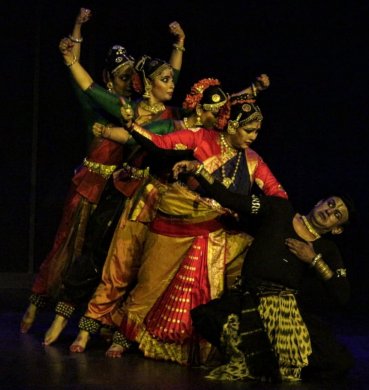
The demon Mahishasura challenges the Devi, who in her multiple forms, defeats him and finally she kills him. Vasudevan plays the role of Mahishasura, and when Devi vanquishes the demon, male dancers dance with joy, releasing the energy, circling the image of the goddess, with gods praising Devi who blesses all. The impact is so overpowering that there is deafening applause from audience, who spontaneously get up and give a standing ovation. The visual of Devi slowly disappears. Vanashree acknowledges the team work, the excellent music provided by a set of musicians including Vasudevan, Kesavan, Venkateswaran, Rajat Prasanna and others. Lighting by Sharad Kulashrestha creates necessary moods. Having choreographed works like Abhimanyu Vadh, Dushasana Vadh earlier, Vanashree has created her own niche in telling stories from mythology with aplomb. She is fortunate in having such a team of excellent male and female dancers. They are the backbone of her Rasa United company. That Vanashree succeeded in having a record of seventy shows of her choreographic works in previous year speaks volumes for excellence of her works and her dancers' high voltage energy. This work Trayambakam is bound to go places. Vanashree and all dancers deserve to be seen again and again.  Dr. Sunil Kothari is a dance historian, scholar, author and critic, Padma Shri awardee and fellow, Sangeet Natak Akademi. Dance Critics' Association, New York, has honoured him with Lifetime Achievement award. Post your comments Please provide your name and email id when you use the Anonymous profile in the blog to post a comment. All appropriate comments posted with name and email id in the blog will also be featured in the site. |